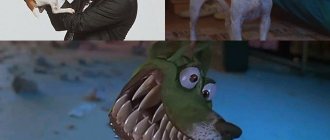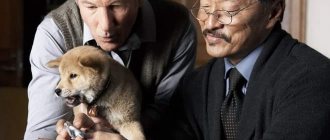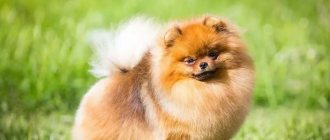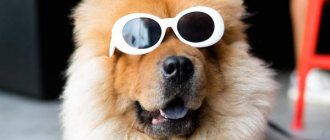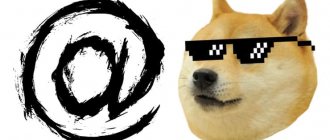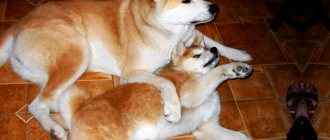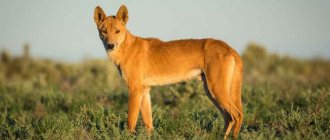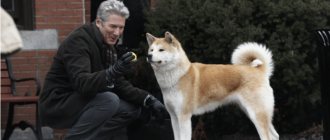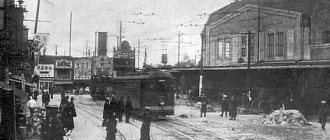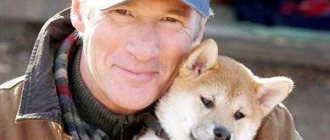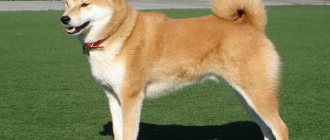Care and maintenance
Mini Akita Inu can live both in a house and in an apartment.
The thick and dense double coat of these dogs allows them to withstand the cold well, but when kept in a yard or enclosure, you need to make sure that the pet has an insulated booth. In the apartment, the Shiba Inu should have its own place, away from heating devices and away from drafts. The place should not be located on the passage, but where the dog could easily observe what is happening in the apartment.
You need to walk your mini Akita twice a day, and, preferably, give the dog the opportunity to run without a leash in a closed area. Caring for her is simple: just comb your pet’s fur from time to time and occasionally bathe it. Moreover, it is recommended to wash your Shiba Inu with soap no more than 2 times a year.
IMPORTANT!
Ears and teeth should be cleaned as they become dirty, and nails should be trimmed when they become so long that they begin to click on the floor.
How to choose a puppy like Hachiko?
The price for a purebred puppy can vary greatly. If you are satisfied with a dubious deal "from hand", then you can count on $400 or less. However, such an acquisition entails risks, so it is better to buy an animal from experienced and reputable breeders, which you can find out about in clubs for Japanese dog lovers.
The name of the Hakito dog breed is on everyone's lips, so scammers often come across. Remember that PET grade puppies (for use as pets) sell for $500 and up. The cost of puppies suitable for further breeding starts from $700, and the price of quality dogs that can win at shows and competitions starts from $1,200.
Before you go for a puppy, it is worth studying the Akita Inu breed standard, which describes the animal’s exterior down to the smallest detail. You can take a specialist with you. Be sure to ask for documents and also look at the Akita's parents.
All puppies in the litter should appear the same size. These are cheerful and fluffy strong creatures, from whom you should not expect eastern restraint and calmness at this age. However, puppies should not be aggressive.
The puppy can be kept both in an apartment and in a country house. Caring for him is not difficult, but it is worth remembering that this breed requires long walks a couple of times a day.
The remains are in the museum
The people of Japan were not ready to say goodbye to Hachiko forever, because such a dog no longer exists. Therefore, after the death of the dog, they made a stuffed animal of him, so that descendants could also see him, remember, and not forget the history of this devoted dog.
You can see the real Hachiko at the Tokyo Art Museum. Despite the long history of the story, the flow of tourists to the museum does not stop, and everyone goes there to see that same dog in person.
But the stuffed animal is just a dog’s fur coat. The rest of his remains were cremated and buried. The faithful dog's grave is located in Tokyo at the Aoyama Cemetery in the Minato-ku area.
Dog breed from the movie Hachiko
It is worth noting that the breed of dog from the film Hachiko - Akita Inu - became more popular in the world precisely thanks to the film. After all, Hachiko is the real life story of a dog that began in 1923. The dog was a pupil of Professor Hidesaburo Ueno, and its name Hachiko is interpreted as the eighth. Uchenii and Khati were inseparable friends, the dog loved his owner with sincere devotion, loved to play with him and follow orders, he had a constant desire to be close to the scientist.
Day after day, every morning, he accompanied the professor to Shibuya station, from where he went to work, and in the evening a lady waited for him there. However, in May 1925, the unpredictable happened: the professor on the robot had a heart attack and died. On that fateful evening, Hachiko, who was already one and a half years old, never met the professor on the platform. But he did not stop waiting, did not stop peering into the crowded streets of the city and looking for the owner.
He never stopped coming to the station every day and waiting for the sun to set, for the professor to arrive, not realizing that he would never see him again. People were moved to tears by Hachiko's story and came to see him, amazed at his perseverance and devotion. Soon the authorities decided to erect a monument to the dog. There were many people at the presentation of the monument, as well as Hachiko himself.
After that, the dog lived for another year and died at the station where, for many years, he faithfully waited for his owner. The day of death of a dog named Hachiko was declared a day of complaint in Japan; it is still a symbol of devotion and fidelity in this country. The remains of the dog are buried at the professor’s grave; it is generally accepted that this is how the long-awaited meeting of these friends took place.
A stuffed animal was made from the dog's skin, which can be seen in one of the museums in Tokyo. During the fighting of the Second World War, the monument to the dog Hachiko was broken. But the sunny country did not forget about the touching story of its legendary dog and restored the monument in 1948. The Americans, in turn, wrote two books about the noble Akita Inu dog, and also made a film of the same name.
Price of dog breed from the movie Hachiko
The Akita Inu dog breed is popular not only because of the film. After all, dogs of this kind have a wonderful character, they never retreat, they never quit, they never give up, they never betray. The Akita Inu is an energetic, independent, cheerful and courageous dog with a balanced character and a high level of intelligence. A striking feature of a dog of this breed is the desire to dominate.
Are you wondering how much the Hachiko dog breed costs? The price of a puppy of this breed depends on many factors. For example: from the color of the coat, from the origin, also from the country from which it comes, from what gender it is, from the city in which the purchase is made.
- Without a veterinary passport, 2-4 month old Akita Inu puppies can be bought for 2500-6000 rubles / 800 UAH;
- With a passport and puppy card - 4000-8000 rubles/1000-1500 UAH;
- In official clubs and nurseries, Akita Inu puppies cost many times more, for example 30,000 rubles / 10,000 UAH;
- Puppies for exhibitions have an even higher price, approximately 2-4 times.
Where to buy an Akita Inu puppy
- Kennel of the Akita Inu breed in Moscow - “Ryuutensou” https://dajlapu.com/japan-akita.ru
- Breed nursery in Kyiv - “Go You Djenima” https://dajlapu.com/www.akita-inu.com.ua
- Akita Inu kennel in Minsk - “Arkhipov Family” https://dajlapu.com/www.akita-dog.by
Now you can independently answer the question, what is the name of the dog breed from the film Hachiko. An interesting fact is that more than one film has been made about the legendary dog. These dogs have a special individual character and external charm, which is why they have become popular among the population. And also, Hachiko is a man’s faithful friend and this is beyond doubt.
For many years the Akita was used as a fighting dog and also as a bear hunter. There are three types of this breed: Akita Matagi, Fighting Akita, Shepherd Akita. Interestingly, the Akita Matagi is crossed with the German Shepherd. Today, this dog is bought in order to welcome another family member into the home, who will be faithful and devoted for many years.
To the future owner
- What to feed the puppy and how many times (feeding schedule and diet by age);
- How to build a dog house with your own hands (drawings, instructions);
- Names for boys dogs and names for girls dogs (lots of cool ones).
Hachiko the dog and cinema
The story of the dog Hachiko’s devotion did not leave cinema indifferent. The deep love, touching and completely disarming loyalty of this selfless creature touched the world's filmmakers to the depths of their souls. In 1987, the Japanese film “The Story of Hachiko” was released, and in 2008, the American film company Grand Army Entertainment released a remake called “Hachiko: The Most Faithful Friend,” where Richard Gere played the main role.
The devoted dog became known all over the world, and now tourists from all over the world who come to Japan definitely include a visit to the Hachiko monument in their itinerary to look at the bronze copy of the legendary dog with their own eyes. And scientists around the world are still trying to unravel the mystery of such extraordinary devotion, which truly amazed the entire planet.
Popular breeds of the world
Among domestic animals, dogs undoubtedly occupy first place. There are so many different breeds that are highly rated. In this article we will talk about the variety of favorites. So, below are popular dog breeds from around the world.
Dachshund. These are short dogs with a long body. This breed has a large number of fans. They are quite loyal, intelligent and loyal. They have enough courage and bravery not to offend their owner. They like to be cunning in order to achieve their goals.
The pug is a decorative dog. Affectionate and kind appearance. Vigorous at 2 to 3 years of age and considered young. Ideal friends for young children. Pugs are quite clean. The character is calm, intelligence is present. The breed is widespread in many countries of the world.
German Shepherd. This dog is considered one of the working dog species all over the world. She is very popular due to her learning ability and resistance to mental disorders. They are non-aggressive and are ready to do anything for their owner. As soon as he senses danger, he will immediately respond to the command. Fearlessness and hard work are the main traits of a shepherd dog. Such dogs become attached to only one owner and also love children.
American Bulldog. They were brought in by the first settlers. The bulldog of this breed is considered a good guard and athlete. Brave, active, hardy and unpretentious dogs have become the workforce. They get along great with children. They must be trained from an early age. Raising a bulldog requires patience and perseverance.
French Bulldog. Charming animals with unusually shaped ears. They are kind and cheerful at heart. This breed is considered inactive and lazy. They are unpretentious to other animals in the house.
Doberman. Dogs belong to aesthetes. They have a graceful and perfect body. Dobermans are very smart and quickly get used to people. They want to be useful to their owner.
Welsh Corgi. One of the most famous breeds in the world. They are distinguished by high intelligence and quick wit. The compact size of this dog makes it easy to move around under guarded livestock. Corgis are ideal for living in the city. They contain a sea of positivity and friendliness.
Chihuahua. Popular tiny dog. They are similar in character to terriers. Audacity, confidence and temperament are clearly expressed. They are distinguished by high adaptability, intelligence and accuracy. They sense the owner's mood. They mature around the age of one year.
Golden retriever. Very friendly dogs. They are very easy to train, as they have high intelligence and an ideal character. Calm and kind animals are used as guide animals. They become strongly attached to all family members. It is not recommended to be left alone.
Poodle. One of the famous ancient breeds, characterized by intelligence and friendliness. Poodles are very energetic and dynamic. They need constant coat care.
Beagle. Dogs with increased activity. They get along well with children and the elderly
Beagles love attention and need a strong hand from their owner.
Main features of Akita Inu
To keep your dog healthy and strong, never buy it from an unknown breeder or pet store. Look for an experienced breeder who closely monitors genetic diseases and has a positive track record.
- Akitas are aggressive towards other dogs and are more prone to same-sex aggression.
- Friendly and consistent communication and early training are needed by all puppies. If you show aggression towards them, they often become angry.
- Akita is not suitable for beginners.
- Akitas will chase other pets in the house.
- The presence of severe shedding.
- Prolonged eye contact is a problem for all dogs of this breed as their response can become aggressive.
Training this breed can be challenging and will require a lot of patience, perseverance and experience.
It is best to work with a trainer who knows the breed, but it is important to do your own training. Now you know what breed of dog was featured in the film Hachiko
Health and life expectancy
The lifespan of an Akita is about 10-12 years. Females live a little longer, but statistically the difference is not very big (only 2-3 months). This indicator is the same for all varieties of this breed. Previously, the life expectancy of Akita was only 14-15 years, but the bombing of Nagasaki and Hiroshima forever left its mark on the genetics of the breed.
Dogs of this breed are healthy and hardy, provided that they do not have congenital defects. Some may have genetic diseases, and there are also pets that are particularly sensitive to medications.
This is what healthy Akita Inu puppies look like
Among acquired and congenital ailments, the most common are:
- hip dysplasia;
- entropy (turning up of eyelids);
- bloating;
- cataract and glaucoma;
- pseudoparalytic myasthenia gravis (muscle weakness);
- von Willerbrand's disease;
- retinal atrophy.
What happened to Hachiko?
The story about Hachiko could remain unknown to the general public. The Japanese professor's relatives left their home and tried to place the dog in a new family. The dog was adopted by a gardener who worked for a long time in the house of Hidesaburo Ueno. But no one can get through to Hachiko’s heart: every time he ran away, returned to the place of his waiting.
The railway station employees noticed that every day he was waiting for the owner, and the wait was not ending in success. Visitors, sellers, and workers began to feed the dog, amazed at his unconditional devotion and perseverance. One of the passers-by was interested in Khati for a long time, sent his photographs and notes to newspapers and magazines. So, in September 1932, a note dedicated to this devoted pet was published in the national publication “Asahi Shimbun”.
It was this article that made the animal famous throughout the world. A huge number of Japanese began to come to Shibuya Station to see for themselves. Thus, the history of Hachiko spread to every corner of Japan and beyond. Already in 1933, there was not a single Japanese who did not know about the dog that was waiting at the station for its owner. From that moment on, the phrase “loyal as a hatiko” began to be used.
Monument to a dog at the station
In 1934, a monument was erected near the station ticket offices at the waiting area for Khachiko. All members of the Hidesaburo Ueno family (grandchildren, children), as well as their devoted four-legged pet, were present at the opening of the sculpture. The ceremony was held a year before Hachiko died. Where and when did the most faithful, persistent dog die? Life on the street left a negative imprint on the animal, and on March 8, 1935, Khachi passed away in the same place where he spent the last 9 years of his life. Japan has recognized March 8 as a day of national mourning.
All citizens of the state said goodbye to Hachiko as a sign of boundless love, devotion and fidelity. Hachiko died far from his loved one, but the ashes were buried next to him. The Japanese believe that the four-legged pet was reunited with its owner after its death. The stuffed dog is kept in the National Museum, which is located in Tokyo. Every person can be convinced of this, because the exhibit has been preserved to this day.
Although the Akita Hachiko Monument was destroyed during World War II, the Japanese were able to restore it. In 1948, the son of the author of the first sculpture repeated the work. Today it is a historical place that is visited by a huge number of tourists. The story of how Hachiko was waiting for his friend is written in a Japanese school textbook. Breed Features
The breed of dog in the film Hachiko and from the real story are not different from each other. The dog presented to the public is Akita or Akita Inu. Like Hachiko, this Japanese dog breed is characterized by loyalty. Representatives of the species protect their owners and household members with special responsibility. They are smart and independent. Hachiko in the film loved his master because the professor earned his respect. It’s the same in real life: the Akita’s respect must be earned, then you will have a faithful and obedient pet.
Friends reunion
The Hachiko dog breed demonstrates impeccable protective qualities and aggression towards other dogs. The latter problem can be easily solved with early training and socialization. The story of Hidesaburo Ueno and Hachi confirms this, since the dog was the eighth pet of the family. If you put love, effort and time into raising an animal, you can end up with a wonderful, intelligent companion with an unwavering sense of loyalty. What breed should I choose for a friend? Akita Inu or large Japanese dog - loyalty, respect and unbreakable love that must be earned.
The story from the film Hachiko shows what boundless devotion and true friendship is between an animal and a person. What dog can wait for its owner for 9 years and 9 months in a row? The Japanese treat Hachi with special reverence, so when he died, national mourning was declared throughout the country. In 2015, staff from the Faculty of Agriculture at the University of Tokyo unveiled a statue that commemorates the long-awaited meeting between Professor Hidesaburo Ueno and Hachi at Shibuya Station. So two loving hearts were able to reunite forever.
Hachiko is a symbol of fidelity and love throughout the world, it is a global heritage.
Read further:
Japanese Fighting Dog: Loyal, Hardy Protector and Companion
Japanese Akita: loyal friend and reliable companion
Einsteins in the dog world: TOP 20 most intelligent breeds
Skye Terrier
Markusha
The Japanese Chin is a sweet and kind dog for those who need a good friend
Hachiko and culture
In 1932, when Hachiko was still alive, an article appeared in the most famous Japanese newspaper published in Tokyo, which talked about the dog’s devotion . When people read the article “A faithful dog is waiting for the return of his owner, who died seven years ago,” they then tried to see this dog. To do this, they gathered at the station and watched Hachiko, touched to the depths of their souls by his behavior.
Already in 1934, the dog was present at the opening of the monument, which was solemnly erected in honor of Hachiko for his devotion and love. But since it was built from metal, during the First World War it was dismantled to give the metal for victory. But already in the post-war period, in 1948, at Shibuya station, where the dog died, a monument to the dog Hachiko from the movie was erected. Now this monument serves as an ideal place for lovers to meet, because it is a symbol of eternity and fidelity.
After Hachiko's death, his entrails were buried next to his owner , and a stuffed animal was made from his skin. It can now be seen in the Japanese National Science Museum.
This true story formed the basis of the film "The Story of Hachiko", which was filmed in Japan in 1987. But in 2009, directors from America created a remake called “Hachiko: The Best Friend.” But the directors added their own vision of this situation to the plot.
Features of the Akita breed
What breed of Hachiko have we already found out, but do such dogs have such features?
- Tends to show aggression towards other dogs, especially of the same sex.
- Akita should be handled by an experienced dog breeder; these dogs are not suitable for beginners.
- Can shed heavily.
- May chase other animals in the house.
- They are difficult to train, so it is best to hire a trainer.
As a result, it should be noted that the dog that was depicted in the film Hachiko is called Akita. This Japanese breed is perfect for a large family, as it is friendly and energetic.
The dog Hachiko was born in November 1923 in the Japanese city of Akita. Soon after his birth, he was presented to Professor Hidesaburo Ueno, who gave him the name Hachiko, which means “eighth.” Why this particular name? The fact is that Hachiko became the professor’s 8th dog.
Hachiko grew up as a very loyal dog and always and everywhere followed the professor. The dog accompanied his owner to work and came to meet him at the same place exactly on time. Such amazing devotion of this dog in the future will make all representatives of the breed symbols of devotion and fidelity.
In May 1925, Hidesaburo Ueno died of a heart attack. At that time, Hachiko was already one and a half years old. And he continued to wait for his master... Every day he came to Shibuya station, as before, and waited for the professor until dusk. And Hachiko spent the night on the porch of his home, which was tightly closed...
The professor's relatives did not abandon the dog. They tried to place Hachiko in familiar families, but despite this, the dog continued to come to the station and wait for its owner. Railway station workers, local merchants and passers-by who knew the whole story never ceased to be amazed at this devotion.
Hachiko became famous throughout Japan in 1932 after the publication of a newspaper with an article about this devoted dog, who had been waiting for more than 7 years for the return of his deceased owner. After this, crowds of people poured into the Shibuya train station to see this devoted dog in person.
So Hachiko came, wanting to meet his master, until his death. For 9 years the faithful dog waited for the professor to return. The day of Hachiko's death became a day of mourning for all Japanese.
In 1934, a monument was erected to the dog, which was destroyed during the World War. The metal from the monument was used for military purposes. But the inhabitants of the Land of the Rising Sun did not forget their hero and, at the end of the war, they restored the monument. Now the Hachiko monument is a favorite meeting place for couples in love. And Hachiko himself became an example for them to follow, a symbol of selfless and deep devotion.
In 1987, the premiere of the film, based on the events of 50 years ago, was released. This film tells about the unbreakable love of a dog for a person. And this year the American version of this film was released, which instantly won the hearts of sentimental viewers. Now the story of Hachiko has become a worldwide property.
And in conclusion, a trailer for the film dedicated to Hachiko.
Japan is mysterious and amazing - a country of contrasts, a country of progress. The land of cherry blossoms and samurai. It has a rich history and many national treasures.
One of them is the Akita Inu dog breed. A detailed overview of the breed follows.
The Japanese Akita Inu dog breed is the largest of the dogs belonging to the Spitz family.
The breed appeared in the 17th century in the town of Akita on the Japanese island of Honshu. But their ancestors are considered to be Matagi Inu, dogs known since the 8th century.
Initially, Inus were used for hunting or guard duty. But gradually their hunting status changed to elite, and the dogs became available only to wealthy people.
After the Second World War, the breed spread throughout Europe and the American continent.
Why was Hachiko waiting for his owner?
It is the desire to taste his favorite delicacy, and not at all passionate devotion to a person, according to museum experts, that is the main reason why the dog invariably came to the capital’s metro station for nine long years. According to this version, one day the owner went on a long business trip.
Interesting materials:
What does Jen mean in Fanfiction? What does it mean on Facebook you can know them? What does it mean in the nominative case? What does it mean to unsend a message on Instagram? What does being a public figure mean on Instagram? What does the amount of declared value mean in the notice? What does it mean in Kchr? What does it mean in the shortest possible time? What does outlet mean in stores? What does an outdated server mean in Minecraft?
Appearance, standard and photo
The Shiba is a relatively small dog with a proportional, harmonious and moderately muscular build. The ratio between height at the withers and body length is 100:110 in males; in females the body format is somewhat more elongated.
The head is of a size commensurate with the body, with a wide skull, a clearly defined transition to a muzzle slightly tapering towards the end. The cheekbones are well defined, and there is a small longitudinal groove on the forehead. The eyes are slightly slanted, small, triangular in shape, their color is one of the shades of dark brown.
The ears are erect, medium-sized, triangular, turned forward. The nose is black. The neck is strong and quite muscular. The back is strong and straight. The stomach is tucked, but not excessively. The tail is set high, curled into a ring on the back.
The limbs are smooth and parallel, moderately muscled and quite strong. The paws are arched, tightly compressed, with elastic and durable pads and dark claws. The coat is very dense and thick, the so-called “wild” type: it consists of a straight and fairly rigid spine and a soft, dense undercoat.
Desirable colors: red, sesame, red sesame, red sesame, black and tan. Sand and white are acceptable, but not desirable.
For any color, “urazhiro” is required - lightening of the fur on the sides of the muzzle, cheekbones, neck, chest, belly, limbs and lower part of the tail.
Next you will see how representatives of this breed look in the photo:
Appearance of Akita Inu and special characteristics of the breed
As already mentioned, the distinctive features of the Akita Inu’s appearance are a large head, small erect triangular ears, a strongly built body, and a tail curled like a donut. This is a fairly hardy dog that thrives in moderate as well as cold climates.
66-71 cm is the average height of a male Akita Inu. The weight of an adult male is 45-59 kg. Female Akitas are slightly smaller in size: height - 61-66 cm, weight - 32-45 kg, but they are more elongated compared to males.
Representatives of this breed do not grow particularly quickly, and the dog’s 100% development is completed only by the age of three. Meanwhile, Akita Inu puppies are actively gaining weight. However, if your pet doesn’t quite fit into the traditional growth and development charts, don’t worry, because these are just generalized data.
Don't worry too much if your puppy's ears don't stand up for a long time: this process can take up to six months. In this case, the ears can rise and fall again. Active gnawing of toys and chewing will help speed up the fixation of the ears in a standing position, and their final shape appears only after the complete change of teeth from milk to permanent.
pixabay.com/uadrienn
In the classic version, the hair of a representative of the breed is dense and short (approximately 5 cm), so the long-haired Akita Inu is rather an exception. However, such dogs, also called “long dogs,” are not classified as a separate breed, because they are full-fledged Akitas, born by crossing ordinary standard-haired dogs endowed with a recessive gene that gives long hair. Longer than normal hair is characteristic of approximately 20-30% of the offspring of the Akita Inu breed.
The color of Akitas in the classic Japanese version does not differ in variety: the dog can be either completely white, or red with white patches and a “mask,” or red with slightly blackened hair tips. There is also a tiger Akita Inu. Black or any other color is allowed only from a representative of the American branch of the breed.
The dog's eyes are dark brown, deep-set, with a characteristic “oriental” shape, distinguishable already from puppyhood. The donut tail visually balances the dog's large head. It may only occasionally unwind - for example, when the pet is resting - but is never completely straight.
A description of the Akita Inu breed will be incomplete without focusing on the dog’s paws. Endowed with thick pads, they look a bit like a cat's
In addition, the animals' toes close quite tightly, as a result of which these dogs swim well, despite the fact that by their nature they do not particularly welcome water procedures.
pixels.com/Zen Chung
What is the name of the small breed, its history
In fact, it would not be entirely correct to talk about this miniature dog as a mini Akita, since at present it is a separate breed called the Shiba Inu. Like most other traditional Japanese breeds, it got its name from the name of the area in which it was bred.
“Dog from Shiba” - this is how it can be translated literally. However, there are other versions. According to one of them, the Shiba got its name from the word “shibafu”, which can be translated as “tuft of grass” by analogy of the color of this animal with the color of sun-dried grass. There is also a hypothesis that the name translates as “dog from the bush forest.”
In any case, it should be recognized that the Shiba is a very ancient breed. Dogs similar to her were found on the territory of modern Japan already three thousand years ago. The history of this breed is noteworthy in that mini Akitas were bred to guard monasteries and only later were they adapted for hunting. The monks treasured these dogs and made sure that the puppies did not fall into the hands of ordinary people, even the nobility.
NOTE! The monks especially valued silence in their dogs, as this helped maintain the silence and atmosphere of serenity so characteristic of Japanese monasteries.
But at the same time, Shiba Inu had to be fast, resilient and have excellent reactions necessary for hunting. For a long time they were bred exclusively in monasteries, but, in the end, these dogs somehow ended up outside their walls and almost immediately became as beloved by local residents as the Akita Inu.
Official breeding of the Shiba in Japan began in 1928, when the Society for the Preservation of Aboriginal Breeds was founded, and these dogs themselves were declared a national treasure. The FCI recognized the Shiba Inu as a breed in 1964. And in Russia, the first representatives of this breed appeared at the very end of the 20th century.
The story behind the film "Hachiko"
Hachiko is a real dog that existed in life. She was born on November 10, 1923. As a puppy she was given to a Japanese professor. Hidesaburo Ueno gave him the name Hashiko, which means eighth in Japanese. This nickname is easy to explain: the professor already had 7 dogs at that time, and Hashiko became the eighth. When the whole world learned about the existence of Hashiko, they began to pronounce his nickname with a European sound. This is how the name Hachiko came about.
Perhaps the world would never have known about Hachiko if the professor had not educated him and taught him to accompany him to the train in the morning and meet him in the afternoon, sitting at the station. Every day for 2 years, Hashiko came to the train station with him, waited until he left for work, and only then slowly went home. Exactly at 15.00 he again came to the platform to meet the owner.
But in May 1925, disaster struck: Hidesaburo Ueno became ill at work. The heart attack was fatal. That day, his pet could not wait for his owner. But for almost 10 years, the professor’s favorite came to the platform at the same time, at 15.00, and waited for the owner. The dog was sleeping on the porch of the house where he grew up and used to live with the professor.
Relatives and even close friends, seeing the dog’s suffering, tried to take Hashiko for themselves, but he still returned to the station and to the porch. Soon all the railway workers and merchants knew Hachiko and admired his devotion. They always recognized him and tried to feed him.
In the spring of 1935, Hachiko was found dead near the station. All the inhabitants of Japan already knew the history of this dog and everyone admired him. But then another circumstance became clear: after examining the body of the dead Hachiko, doctors discovered that he had the last stage of cancer, and he died of a heart attack. Since that day, March 8, the day of Hachiko’s death, was declared a day of mourning, and Hachiko himself, an Akita Inu breed, became a symbol of devotion. Now all dogs of this breed are considered the most loyal.
History of character creation
The true story of the dog that formed the basis of Hachiko's book and film
The Akita Inu dog was born on a farm in a prefecture in northern Japan. The owner kept it with him for a year, and then gave it to a professor who taught agriculture at the University of Tokyo.
Richard Gere and Hachiko (still from the film)
Professor Ueno happily accepted the gift, naming the dog Hachiko, which means “eight” in Japanese. Every day, when leaving for work, the dog followed him and greeted him from work every day.
Everything was like a fairy tale until the puppy was one and a half years old, and as usual he was waiting for his owner from work. But Ueno did not return - he died right at his workplace during a lecture. Kind people picked up the dog and gave him to other owners. But the real Hachiko could not bear the loss, he constantly ran to the station and took his place, expecting that he, his owner, would appear in the crowd of people.
Important! In the film, an American Akita dog was chosen to play the role of the dog, rather than an Akita Inu.
Character of the breed
The Akita Inu is considered a brave dog with a willful personality that is afraid of strangers but is very loyal to its family. She is alert, intelligent and courageous. Akitas are usually aggressive towards other animals of the same sex. The Akita is ideal for a family with one dog.
In the family, this breed is affectionate and playful. She is considered an eternal companion to the joint activities of the family. She loves to play with toys and various household items. Despite the general opinion that the Akita never barks, in fact it is very noisy, it can grumble, get angry, and bark loudly. Be aware that the Akita's personality can be depressing. This dog is not suitable for beginners or timid owners. She requires firmness and consistency from her owner, who will provide her with the necessary level of discipline. To prevent your dog from getting bored, he will need a lot of exercise and physical activity. Otherwise it can lead to self-destruction. The breed's natural defensive reaction is to be aggressive. Therefore, training and competent communication of the breed plays a special role from a very early age. This breed is stubborn and you will need a lot of patience to teach it the right manners.
Children and other animals
Adults should always supervise interactions between dogs and children, especially with this breed. No child could have a more loyal companion and protector than an Akita - however, mistreatment can become irresponsible, and can even threaten your child's health. It is extremely important to teach your child to be respectful and kind in all interactions with the dog.
However, the Akita is more suitable for families with older children. These dogs should live in a loving, one-dog family as they are aggressive towards other dogs and animals.
Features of the Akita breed
Akita is an amazing animal. Her look, movements and gait speak of fortitude and nobility. The dense physique is explained by ideal proportions and extraordinary appearance. It is the grace and confidence of this dog that attracts owners.
Description and characteristics of the breed
The Akita Inu has a peculiar appearance - a large head, small almond-shaped eyes. The strong body of a dog is the main factor that has a terrifying effect on the enemy. The breed is distinguished by its loyalty to its owner, tenderness and kindness towards loved ones. And what could be better than a loving and strong patron?
Proud and wayward breed
A dog of this breed is not prone to barking, but at the same time it is quite vocal. The thing is that Akita owners often noticed how their pets made different sounds such as groans, grunts, and snorts. Some even say that it seems as if the dog is talking to itself.
A small representative of this breed is a reserved dog, he is careful with strangers. At the same time, he is very careful and does not show aggression towards strangers.
Attention! It is important not to give in to slack, because as soon as the dog feels that it is stronger, it will be impossible to take power over it.
Purpose and character of the dog
Akita Inu dogs were originally bred to guard the royal family. The dog's impressive and strong body constitution matches well with the overall appearance of a guard dog. Despite their menacing appearance, Akita Inu are very affectionate, love their owners and are great with children.
The Tiger Akita Inu is particularly friendly to children.
The dog Hachiko is an excellent companion, despite his stubbornness. At first, there may be problems with training and teaching the dog commands. Representatives of this breed love to demonstrate dominance and assertiveness of character. They are unlikely to be suitable for novice dog breeders, but for those who have patience and a great desire to acquire a loyal friend, the Akita will be the best solution.
Education and training
Akita Inu is a difficult breed to train. This is due to the complex nature of the dog. A coach must have all the qualities of a leader, but most importantly, he must be self-confident. Persistence and consistency are the main components of successful and correct training.
Since the Akita Inu was originally bred as a hunting dog, it is always very wary of anything unknown. This is why the process of early socialization of a puppy of this breed is of great importance. During the socialization period, puppies must understand what is dangerous and what is not. The dog must also distinguish between the owner's friends and uninvited guests, at whom he can bark and growl.
How to properly keep an Akita Inu
Akita dogs come in a variety of colors, including white, black, brindle, and chocolate. They have a characteristic thick undercoat. In general, caring for an Akita is not difficult, however, if the dog lives at home, you need to be prepared for the fact that hair will be everywhere - on furniture and on clothes. Therefore, you need to increase the number of cleanings, or better yet, get a good vacuum cleaner.
For your information! Heavy shedding occurs twice a year. During this period, you need to comb your pet every week and give it vitamins for its coat so that it is always beautiful and healthy.
Despite the fact that dogs of the Hachiko breed tend to take care of themselves, breeders still recommend bathing her once every three months. This is especially true for those representatives of the breed who walk a lot on the street and love to roll in the mud.
Ear care involves careful weekly monitoring of the condition of the ear canals and treatment with a pH-balanced solution prescribed by a veterinarian.
It is also important to prevent inflammation or irritation in the ears. Nails need to be trimmed once a month
Key factors when choosing a puppy and the price range of the breed
You should buy purebred puppies only from trusted and reliable breeders. The main signs of a healthy dog are as follows:
- cheerful and lively;
- average fatness;
- with beautiful shiny coat;
- runs confidently and stands firmly on its feet;
- not aggressive, not afraid of new sounds.
Particular attention is paid to the shape and color of the eyes - if they are light in color and round, then this indicates that the dog is not purebred. The unusual shape of the eyes is a congenital feature, and with age only the color can change, becoming lighter.
The bite should be correct, and the pigmentation of the mouth and nose should be uniform. If you buy a puppy older than 6 months, and its tail is not curled, this is a bad sign.
White Akita is one of the most beautiful representatives of the breed
When choosing a dog to participate in tournaments and competitions, it is better to contact an experienced dog handler. And, if the main goal is to acquire a companion and a faithful friend, then all of the above characteristics will help you make a choice in favor of a cheerful and healthy Akita.
The standard cost of a purebred baby is about 30 – 80,000 rubles*. Such a large discrepancy in price is explained by the following factors:
- Color. Sesame Akitas are a real rarity, and therefore they are highly valued and cost the most.
- Pedigree. Famous champion parents also add several thousand to the cost.
- Nursery. Each breeder independently determines the price of puppies.
- Compliance. The cheapest Akita Inu puppies are those with long hair. They are also called long ones. The thing is that they cannot take part in competitions, however, they are perfect for keeping in an apartment or private house.
Be that as it may, after the information presented above, it became known what kind of animal Hachiko is. Surely, many people wanted to get an Akita Inu and start training it for themselves.
Do not forget that these puppies are not suitable for everyone, and therefore you should soberly assess the situation, take into account all the pros and cons, and only then go to the nearest kennel to find a purebred dog that will be in many ways similar to its future owner.
*Prices are current as of February 2022.
